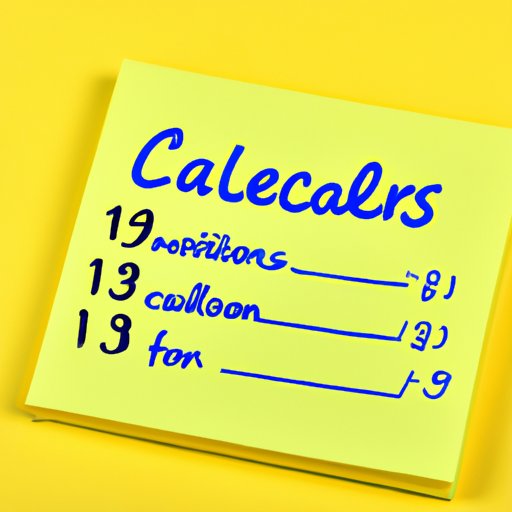
I. Introduction
One of the biggest challenges for people trying to lose weight is determining the right calorie intake for their goals. With so much conflicting information out there, it can be overwhelming to figure out how many calories to consume daily in order to lose weight. This article aims to provide a comprehensive guide to calculating your daily calorie needs, understanding calorie deficits, nutrition for weight loss, tracking calories, exercise for weight loss, overcoming plateaus, and adopting a positive mindset towards weight loss.
II. Calculating Your Daily Calorie Needs
Basal Metabolic Rate (BMR) is the amount of energy your body needs to perform basic metabolic functions while at rest. It is influenced by several factors, such as age, gender, height, weight, and activity level. To determine your daily calorie needs, you need to know your BMR and activity level. The formula for estimating daily calorie needs is: Daily Calorie Needs = BMR x Activity Factor.
III. Understanding Calorie Deficits
A calorie deficit is the amount of calories your body burns more than it takes in. It is the key to weight loss, as it forces your body to utilize stored fat for energy. To create a calorie deficit, you need to reduce your calorie intake through diet or increase your calorie burn through exercise, or a combination of both. An appropriate calorie deficit is around 500-1000 calories per day, as a larger deficit may lead to muscle loss and slower metabolism.
IV. Nutrition for Weight Loss
A balanced diet is crucial for sustainable weight loss. Protein, fiber, and healthy fats are particularly important, as they make you feel full, boost metabolism, and preserve muscle mass. Examples of foods rich in these nutrients are lean meats, fish, nuts, seeds, fruits, vegetables, and whole grains. Avoid sugary, processed, and high-fat foods, as they are calorie-dense but nutrient-poor.
V. Tracking Calories
Tracking your daily calorie intake is essential to ensure you stay within your target range. There are various apps, journals, and websites that can help you track your calories easily. Ideally, you should aim to consume 80-85% of your daily calorie needs from nutritious foods and the remaining 15-20% from discretionary or treat foods. However, be mindful of potential calorie underestimation and overestimation errors and keep adjusting your intake based on your progress.
VI. Exercise for Weight Loss
Exercise is not only beneficial for burning calories but also for improving overall health and well-being. Cardio and strength training are both effective for weight loss. Cardio raises heart rate and burns calories, while strength training builds muscle and increases metabolism. Aim for at least 150 minutes of moderate-intensity exercise or 75 minutes of vigorous-intensity exercise per week, along with two sessions of strength training per week. Gradually increase the intensity and duration of your workouts over time.
VII. Plateaus and Adjustments
Weight loss plateaus are a normal part of the weight loss process, as the body adapts to changes. To overcome them, you need to make adjustments to your calorie intake or exercise routine. Try changing the type, duration, or intensity of your workouts, or cutting back 100-200 calories from your daily intake. Stay patient and consistent, and don’t get discouraged by temporary setbacks.
VIII. Mindset for Weight Loss
Mental and emotional factors greatly influence weight loss success. The right mindset is critical for staying motivated and disciplined. Set realistic and specific goals, celebrate every small progress, and seek support from family, friends, or online groups. Don’t let setbacks or slip-ups derail you, but instead learn from them and keep moving forward. Embrace a healthy lifestyle instead of a quick-fix diet mentality.
IX. Conclusion
Losing weight requires finding the right calorie balance for your body and lifestyle. Calculate your daily calorie needs, create a calorie deficit through diet and exercise, eat a balanced diet rich in protein, fiber, and healthy fats, use various tools to track your calorie intake, exercise regularly, make adjustments when necessary, and cultivate a positive mindset. It may not be easy, but it’s worth it for the health and happiness benefits that come along with it.





